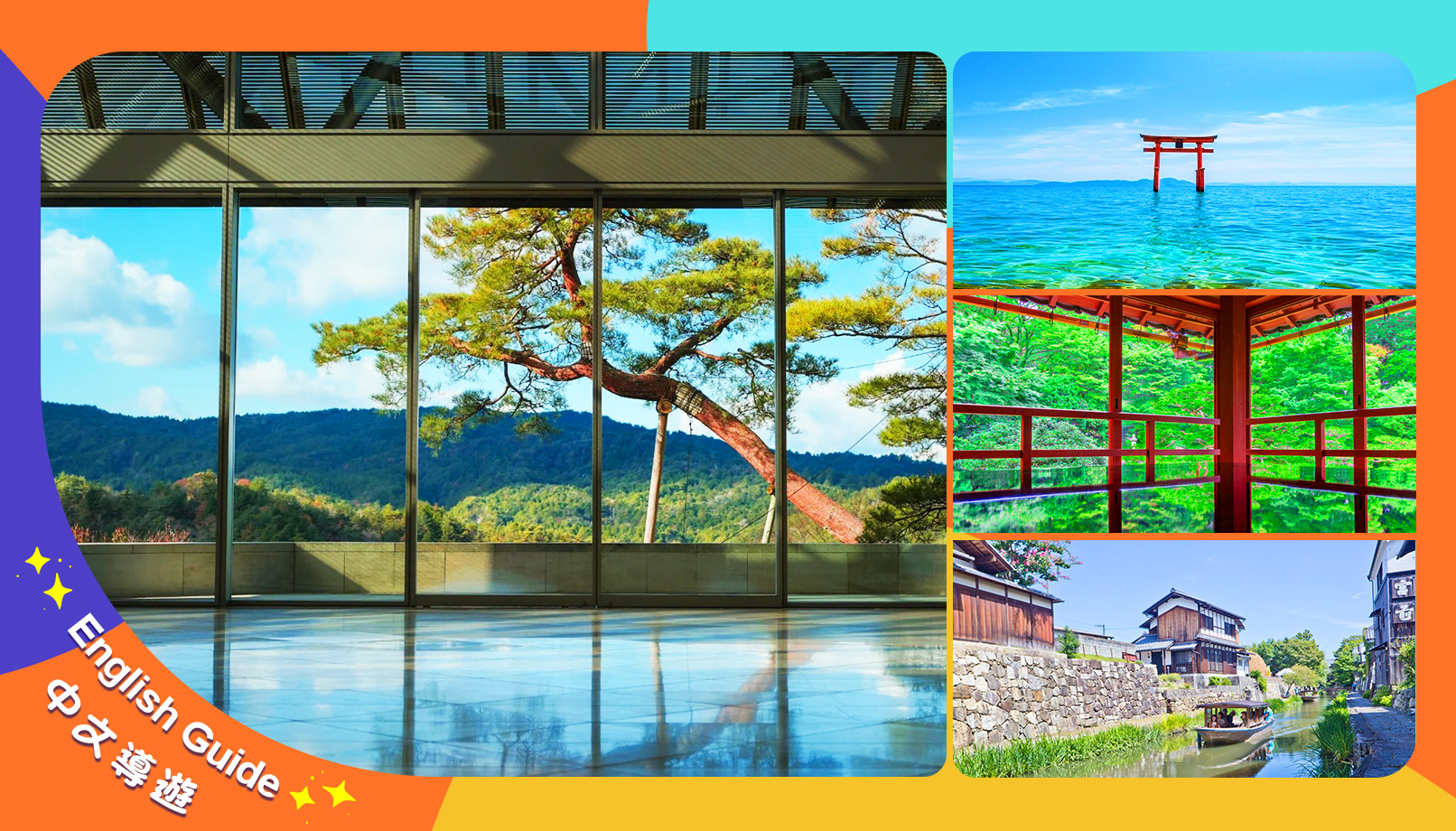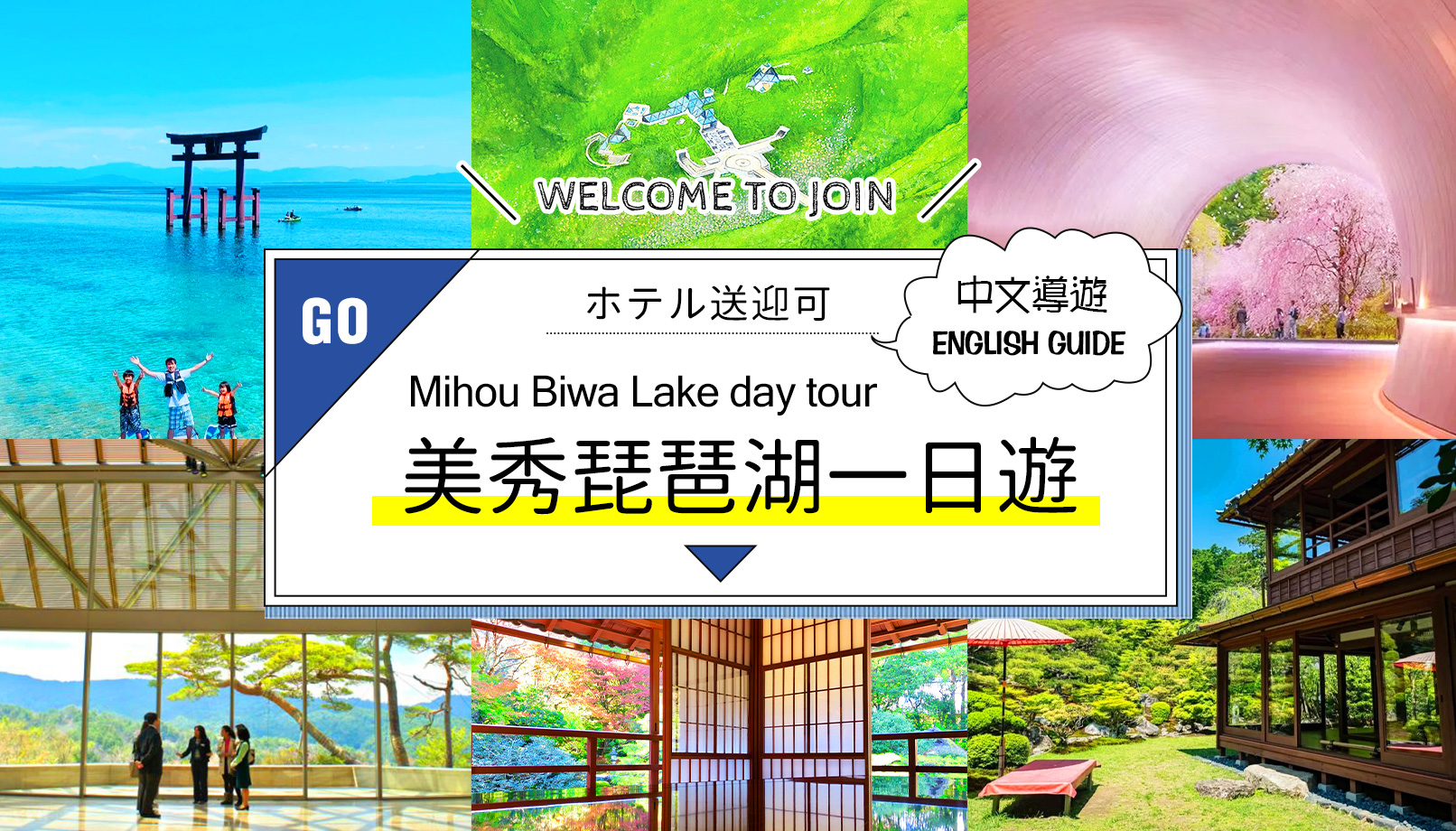
Shiga-Otsu Day Tour: MIHO Museum, Former Chikurinin Temple & Lake Biwa Shirahige Shrine (Depart from Osaka and Kyoto) | Japan
- Visit the MIHO Museum, designed by I.M. Pei. It is a harmonious blend of architecture and nature, and a must-see for art and design lovers
- Experience the mystical charm of Shirahige Shrine, known as the “floating shrine of Japan,” where the torii gate stands beautifully in the water, stunning in every season
- Explore the Former Chikurin-in Temple, featuring a traditional kare-sansui (dry landscape) garden and immerse into Edo-period aesthetics and tranquility
- Depart from Osaka or Kyoto with ease, this one-day journey unveils Shiga's cultural treasures and breathtaking natural scenery
Options
Pick up at designated location
Additional Info
Children aged 0-2 years old can travel for free if they do not occupy a seat; please inform us in advance; children aged 3 years old and above travel the same as adults.
What's included in Shiga-Otsu Day Tour: MIHO Museum, Former Chikurinin Temple & Lake Biwa Shirahige Shrine (Depart from Osaka and Kyoto) | Japan
(Subject to Option Inclusions)Itinerary
Hotel or B&B pickup within the Osaka Loop Line: The order and time of pickup will be arranged by the driver based on the distance of the journey. Please understand and cooperate with each other and follow the driver's arrangements.

Designated pick-up and drop-off plan - Nihonbashi Subway Station Exit 2 (Namba Shinsaibashi area)

Designated Pick-up and Drop-off Plan - Kyoto Station Hachijo Exit Sightseeing Bus Parking Lot

MIHO Museum: Pei's Utopia (about 2 hours, including lunch and free time)

Old Bamboo Forest: Tickets are at your own expense. Closed on Mondays (not closed on holidays), the day after holidays, 12/26-12/31 (about 60 minutes)

You can enjoy the garden landscape while savoring the perfect taste of matcha, or you can walk through the exquisitely arranged mountain stream stone steps and experience the Zen in the Japanese garden.

If the old Chikurin-in Temple is closed, we will go to Hieisan Hiyoshi Taisha Shrine (about 60 minutes)

Lake Biwa: Shirahige Shrine Water Torii Gate (about 30 minutes)

Kyoto Station Hachijo Exit. If you need to get off in Kyoto, please get off here.
Arriving at the Shinsaibashi area, guests who wish to disband in Osaka can disband and end their trip here.
Guests who need to be sent back to the hotel or B&B, please wait patiently for the shuttle bus to arrive and send them back to the hotel (the shuttle bus arrival time depends on the road conditions). The above itinerary time arrangement may be adjusted accordingly due to weather, road conditions, etc., please understand
The above attractions and time arrangements may be subject to force majeure factors such as weather and road conditions, and the tour guide has the right to make corresponding adjustments. In order to avoid losses, please do not arrange other activities on the same night, thank you for your understanding.







The content of this product is provided by machine translation and may not reflect the actual information, please take this into consideration before booking.
—Introduction to attractions—
- MIHO Museum: Pei’s Paradise
MIHO Museum of Art was designed by the famous architect Mr. I.M. Pei, based on the concept of "Peach Blossom Spring". It is far away from the city. The most special thing is that 80% of the building is buried in the mountains. In summer, the forests are lush and the mountain roads are long. In winter, the mountain is closed due to heavy snow. The collection includes artworks from ancient civilizations such as Japan, China, South Asia, Central Asia, West Asia, Egypt, Greece, and Rome. ※Opening date official website http://www.miho.or.jp/calendar/ Permanent exhibition ticket: 1100 yen; special exhibition ticket 1300 yen. Lunch recommendation (please pay for it yourself) There are restaurants and cafes in the museum, please feel free to choose your own meals.
* Museum closure dates: March 24, 31, 2025, April 7, 14, 21, 28, 2025, May 7, 12, 19, 26, 2025, June 2, 2025, June 9, 2025 - July 11, 2025, July 14, 22, 28, 2025, August 4, 12, 18, 2025, August 25, - September 19, 2025, September 22, 29, 2025, October 6, 14, 20, 27, 2025, November 4, 10, 17, 25, December 8, 2025, December 15-31, 2025
- Former Chikurin-in Temple
The national designated scenic garden where you can enjoy the beautiful scenery of different seasons was once the retreat of the monks on Mount Hiei. Recommended by Japanese photographers, the layout of the attic in the courtyard is the same as that of Rurikoin, and you can take the same mirror reflection, and there is no interruption and no time limit, so you can slowly find the perfect angle. The courtyard is covered with moss, and each season has its own characteristics. You can enjoy the courtyard landscaping while tasting the perfect taste of matcha, or you can walk through the exquisitely arranged mountain stream stone steps and experience the Zen in the Japanese courtyard. Tickets are self-paid: 330 yen; tasting matcha + Japanese confectionery in the courtyard: 400 yen.
*Go to Taisha Shrine when the Former Chikurin-in Temple is closed (on Mondays, the day after a holiday, and 12/26-12/31) Mount Hiei Taisha Shrine: The head shrine of more than 3,800 Hie, Hiyoshi, and Sanno Shrines in Japan, "Hieyoshi Taisha Shrine" uses monkeys as messengers of God.
- Lake Biwa Shirasu Shrine Water Torii
Lake Biwa is a freshwater lake in the mountainous area of central and western Japan, close to Kyoto. It is a symbol of Japan, a national park and the largest lake. It is a designated lake under the Law on Special Measures for the Preservation of Lake and Marsh Water Quality in Japan and is listed in the Ramsar Convention on Wetlands as an internationally important wetland. Like Mount Fuji, Lake Biwa is regarded by the Japanese as a symbol of Japan and is affectionately called the "Lake of Life".
- Shinsaibashi
Osaka's most famous shopping street is home to large department stores, chain drugstores, old brand stores, and small shops. There are all kinds of goods of all grades and styles, and Hello Kitty and Disney stores are also here. This is also a gathering place for drugstores, and most stores are equipped with Chinese-speaking staff, so you can easily enjoy shopping.
- Dotonbori
Whether it is day or night, this street never rests. As the birthplace of Osaka's food culture, Dotonbori has many delicious snacks such as octopus balls, Okonomiyaki, and Jinlong ramen, as well as traditional Japanese izakayas and various restaurants, such as the popular Kani Doraku.
Other day trip recommendations:
—Important Notes—
- Each person can bring one piece of luggage for free, with no size limit. The excess will be charged 2,000 yen per piece (please note when registering).
- Children aged 0-2 years old can ride for free without occupying a seat; please inform us in advance when registering; children aged 3 years old and above ride the same as adults.
- Small groups of 1-13 people will have driver who also serves as the guide. For bus groups of 14-45 people there will be a driver and a guide. The arrangement will be made according to the number of participants in the group on the day.
- Reference vehicle types: 5-8 seater: Toyota Alphard or equivalent. 9-14 seater: Toyota HAICE or equivalent. 18-22 seater: mini bus. 22 seater or more: large bus. The above vehicles are for reference only and will be adjusted according to the number of people in the group on the day.
Inclusions
- Service charge
- Parking fee
- Toll fee
- Fuel cost
- Driver
- Dining expenses
- Attraction tickets
- Other expenses not mentioned above
- A minimum of 4 traveler(s) are required for the tour to depart. If the number of participants does not reach the minimum requirement, the tour will be canceled. An email regarding tour cancellation will be sent 4 day(s) before the departure date
- In the event of inclement weather such as typhoons or snowstorms, a decision on whether to cancel the tour will be made 1 day(s) before departure (local time 18:00). Notifications will then be sent via email
- Please arrive at the designated location 15 minute(s) before the scheduled departure time, as the tour will depart on time
- During the trip, please carry your passport and valuables with you and keep them properly. If they are lost, stolen, or damaged, you will be responsible for the consequences.
- Elderly people, patients with cardiovascular diseases such as hypertension and heart disease, and pregnant women are advised to be accompanied by their relatives.
- This tour does not accept individual registrations from customers under the age of 18. If you wish to register, please have your guardian register with you.
- This is a fixed carpooling itinerary. Please be sure to abide by the stay time at each attraction and follow the arrangements of the driver and guide.
- Please note that no refund will be given if you fail to participate or cancel the trip due to personal issues, lateness, etc.
- If you leave the group on your own during the trip, the transaction will be deemed invalid and no fees will be refunded. If personal or property safety is affected as a result, the consequences will be borne by you.
- The arrival time of each itinerary may change due to traffic conditions, weather, festivals, and crowds on the day. Please forgive us if the itinerary is delayed or cancelled due to the above or other force majeure factors. We cannot request a refund on this basis.
- Please be sure to abide by local laws and regulations in Japan and do not bring items prohibited by Japanese law to avoid violating the law and affecting your own rights.
- During free activities, you should pay attention to your own personal and property safety. If you fail to heed the advice and an accident or loss occurs, you will be responsible for the consequences.
- The boarding and alighting locations must be the same and cannot be changed.
- The journey is long, so it is recommended to wear comfortable and convenient clothing, and prepare some light food and drinking water in advance to ensure a more pleasant and smooth journey.
Meet
Venues
- Nihonbashi Subway Station Exit 2Until08:40View on Map
- Kyoto Station Hachijo Exit Sightseeing Bus Stop In Front Of The StationUntil09:50View on Map
Meeting / End Points
- MIHO Museum
Policies
Purchase Summary
【Travel conditions】
- Travel origin and destination: Osaka and Shiga
- Travel days: Round trip
- Transportation: Chartered bus
- Bus company name: Reisei Tourism Industry Co., Ltd., etc
- Meals: Breakfast 0 times Lunch 0 times Dinner 0 times
- Accommodation facilities: None
- Minimum number of people in a group: 4
- Team Leader: 1
【Travel planning/implementation】
- Operating company name: TuYi Group Japan Co., Ltd.
- Address: 722 Shuzenji, Izu City, Shizuoka Prefecture
- License Number: Shizuoka Prefectural Governor Registered Travel Agency, No. 2-633
- Travel Agency Association: Regular Member of the Japan Association of Travel Agents (JATA)






![Enjoy forest play in Shiga Prefecture! Treetop athletics that the whole family and friends can enjoy together [Forest Adventure, Ritto]](https://image.kkday.com/v2/image/get/w_480,c_fit,q_85,wm_auto/s1.kkday.com/product_262899/20241129030709_0AwCX/jpg)